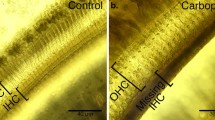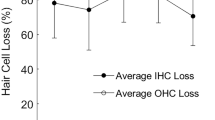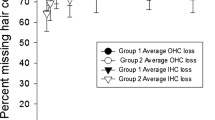Abstract
Poorer hearing in the presence of background noise is a significant problem for the hearing impaired. Ototoxic drugs, ageing, and noise exposure can damage the sensory hair cells of the inner ear that are essential for normal hearing sensitivity. The relationship between outer hair cell (OHC) loss and progressively poorer hearing sensitivity in quiet or in competing background noise is supported by a number of human and animal studies. In contrast, the effect of moderate inner hair cell (IHC) loss or dysfunction shows almost no impact on behavioral measures of hearing sensitivity in quiet, when OHCs remain intact, but the relationship between selective IHC loss and hearing in noise remains relatively unknown. Here, a moderately high dose of carboplatin (75 mg/kg) that produced IHC loss in chinchillas ranging from 40 to 80 % had little effect on thresholds in quiet. However, when tested in the presence of competing broadband (BBN) or narrowband noise (NBN), thresholds increased significantly. IHC loss >60 % increased signal-to-noise ratios (SNRs) for tones (500–11,300 Hz) in competing BBN by 5–10 dB and broadened the masking function under NBN. These data suggest that IHC loss or dysfunction may play a significant role in listening in noise independent of OHC integrity and that these deficits may be present even when thresholds in quiet are within normal limits.






Similar content being viewed by others
Abbreviations
- ABR:
-
Auditory brainstem response
- AC:
-
Auditory cortex
- CAP:
-
Compound action potential
- CM:
-
Cochlear microphonics
- dB:
-
Decibel
- DPOAE:
-
Distortion product otoacoustic emissions
- IC:
-
Inferior colliculus
- IHC:
-
Inner hair cell
- OHC:
-
Outer hair cell
- PTCs:
-
Psychophysical tuning curves
- SD:
-
Standard deviation
- SEM:
-
Standard error of the mean
- SPL:
-
Sound pressure level
- SDH:
-
Succinate dehydrogenase
References
Allen JB (1980) Cochlear micromechanics—a physical model of transduction. J Acoust Soc Am 68:1660–1670
Arnold S, Burkard R (2002) Inner hair cell loss and steady-state potentials from the inferior colliculus and auditory cortex of the chinchilla. J Acoust Soc Am 112:590–599
Bharadwaj HM, Verhulst S, Shaheen L, Liberman MC, Shinn-Cunningham BG (2014) Cochlear neuropathy and the coding of supra-threshold sound. Front Syst Neurosci 8:26
Bharadwaj HM, Masud S, Mehraei G, Verhulst S, Shinn-Cunningham BG (2015) Individual differences reveal correlates of hidden hearing deficits. J Neurosci 35:2161–2172
Blakeslee EA, Hynson K, Hamernik RP, Henderson D (1978) Asymptotic threshold shift in chinchillas exposed to impulse noise. J Acoust Soc Am 63:876–882
Borg E (1987) Loss of hair cells and threshold sensitivity during prolonged noise exposure in normotensive albino rats. Hear Res 30:119–126
Clark WW, Clark CS, Moody DB, Stebbins WC (1974) Noise-induced hearing loss in the chinchilla, as determined by a positive-reinforcement technique. J Acoust Soc Am 56:1202–1209
Cody AR, Russell IJ (1985) Outer hair cells in the mammalian cochlea and noise-induced hearing loss. Nature 315:662–665
Coleman JW (1976) Hair cell loss as a function of age in the normal cochlea of the guinea pig. Acta Otolaryngol 82:33–40
Dallos P, Harris D (1978) Properties of auditory nerve responses in absence of outer hair cells. J Neurophysiol 41:365–383
Davis RI, Ahroon WA, Hamernik RP (1989) The relation among hearing loss, sensory cell loss and tuning characteristics in the chinchilla. Hear Res 41:1–14
Davis B, Qiu W, Hamernik RP (2005) Sensitivity of distortion product otoacoustic emissions in noise-exposed chinchillas. J Am Acad Audiol 16:69–78
Ding D, Li M, Zheng X, Wang J, Salvi RJ (1999a) Cochleogram for assessing hair cells and efferent fibers in carboplatin-treated ear. Lin Chuang Er Bi Yan Hou Ke Za Zhi 13:510–512
Ding DL, Wang J, Salvi R, Henderson D, Hu BH, McFadden SL, Mueller M (1999b) Selective loss of inner hair cells and type-I ganglion neurons in carboplatin-treated chinchillas. Mechanisms of damage and protection. Ann NY Acad Sci 884:152–170
Egan JP, Hake HW (1950) On the masking pattern of a simple auditory stimulus. J Acoust Soc Am 22:622–630
El-Badry MM, McFadden SL (2007) Electrophysiological correlates of progressive sensorineural pathology in carboplatin-treated chinchillas. Brain Res 1134:122–130
Furman AC, Kujawa SG, Liberman MC (2013) Noise-induced cochlear neuropathy is selective for fibers with low spontaneous rates. J Neurophysiol 110:577–586
Giraudi D, Salvi R, Henderson D, Hamernik R (1980) Gap detection by the chinchilla. J Acoust Soc Am 68:802–806
Giraudi-Perry DM, Salvi RJ, Henderson D (1982) Gap detection in hearing-impaired chinchillas. J Acoust Soc Am 72:1387–1393
Greenwood DD (1990) A cochlear frequency-position function for several species--29 years later. J Acoust Soc Am 87:2592–2605
Hamernik RP, Patterson JH, Turrentine GA, Ahroon WA (1989) The quantitative relation between sensory cell loss and hearing thresholds. Hear Res 38:199–211
Heffner RS, Heffner HE (1991) Behavioral hearing range of the chinchilla. Hear Res 52:13–16
Hofstetter P, Ding D, Salvi R (1997a) Magnitude and pattern of inner and outer hair cell loss in chinchilla as a function of carboplatin dose. Audiology 36:301–311
Hofstetter P, Ding D, Powers N, Salvi RJ (1997b) Quantitative relationship of carboplatin dose to magnitude of inner and outer hair cell loss and the reduction in distortion product otoacoustic emission amplitude in chinchillas. Hear Res 112:199–215
Johnstone BM, Patuzzi R, Yates GK (1986) Basilar membrane measurements and the travelling wave. Hear Res 22:147–153
Kujawa SG, Liberman MC (2009) Adding insult to injury: cochlear nerve degeneration after “temporary” noise-induced hearing loss. J Neurosci 29:14077–14085
Liberman MC, Dodds LW (1984) Single-neuron labeling and chronic cochlear pathology. III. Stereocilia damage and alterations of threshold tuning curves. Hear Res 16:55–74
Lin HW, Furman AC, Kujawa SG, Liberman MC (2011) Primary neural degeneration in the Guinea pig cochlea after reversible noise-induced threshold shift. J Assoc Res Otolaryngol 12:605–616
Lobarinas E, Salvi R, Ding D (2013) Insensitivity of the audiogram to carboplatin induced inner hair cell loss in chinchillas. Hear Res 302:113–120
Makary CA, Shin J, Kujawa SG, Liberman MC, Merchant SN (2011) Age-related primary cochlear neuronal degeneration in human temporal bones. J Assoc Res Otolaryngol 12:711–717
McFadden SL, Ding D, Jiang H, Woo JM, Salvi RJ (2002) Chinchilla models of selective cochlear hair cell loss. Hear Res 174:230–238
McGill TJ, Schuknecht HF (1976) Human cochlear changes in noise induced hearing loss. Laryngoscope 86:1293–1302
Miller JD (1970) Audibility curve of the chinchilla. J Acoust Soc Am 48:513–523
Moore BC, Huss M, Vickers DA, Glasberg BR, Alcantara JI (2000) A test for the diagnosis of dead regions in the cochlea. Br J Audiol 34:205–224
Niemiec AJ, Yost WA, Shofner WP (1992) Behavioral measures of frequency selectivity in the chinchilla. J Acoust Soc Am 92:2636–2649
Nienhuys TG, Clark GM (1979) Critical bands following the selective destruction of cochlear inner and outer hair cells. Acta Otolaryngol 88:350–358
Ohlms LA, Lonsbury-Martin BL, Martin GK (1991) Acoustic-distortion products: separation of sensory from neural dysfunction in sensorineural hearing loss in human beings and rabbits. Otolaryngol Head Neck Surg 104:159–174
Patuzzi RB, Yates GK, Johnstone BM (1989) Outer hair cell receptor current and sensorineural hearing loss. Hear Res 42:47–72
Prazma J, Postma DS, Pecorak JB, Fischer ND (1976) Ototoxicity of tobramycin sulfate. Laryngoscope 86:259–268
Preyer S, Gummer AW (1996) Nonlinearity of mechanoelectrical transduction of outer hair cells as the source of nonlinear basilar-membrane motion and loudness recruitment. Audiol Neurootol 1:3–11
Prosen CA, Halpern DL, Dallos P (1989) Frequency difference limens in normal and sensorineural hearing impaired chinchillas. J Acoust Soc Am 85:1302–1313
Robertson LF, Salvi RJ, Poon M, Powers NL (1990) Evoked potential tone-on-tone masking patterns in the chinchilla. Am J Otol 11:431–436
Ryan A, Dallos P, McGee T (1979) Psychophysical tuning curves and auditory thresholds after hair cell damage in the chinchilla. J Acoust Soc Am 66:370–378
Ryan AF, Woolf NK, Bone RC (1980) Ultrastructural correlates of selective outer hair cell destruction following kanamycin intoxication in the chinchilla. Hear Res 3:335–351
Salvi RJ, Arehole S (1985) Gap detection in chinchillas with temporary high-frequency hearing loss. J Acoust Soc Am 77:1173–1177
Salvi RJ, Hamernik RP, Henderson D (1978) Discharge patterns in the cochlear nucleus of the chinchilla following noise induced asymptotic threshold shift. Exp Brain Res 32:301–320
Salvi RJ, Wang J, Ding D (2000a) Auditory plasticity and hyperactivity following cochlear damage. Hear Res 147:261–274
Salvi RJ, Ding D, Wang J, Jiang HY (2000b) A review of the effects of selective inner hair cell lesions on distortion product otoacoustic emissions, cochlear function and auditory evoked potentials. Noise Health 2:9–26
Santi PA, Ruggero MA, Nelson DA, Turner CW (1982) Kanamycin and bumetanide ototoxicity: anatomical, physiological and behavioral correlates. Hear Res 7:261–279
Saunders JC, Mills JH, Miller JD (1977) Threshold shift in the chinchilla from daily exposure to noise for six hours. J Acoust Soc Am 61:558–570
Seaton WH, Trahiotis C (1975) Comparison of critical ratios and critical bands in the monaural chinchilla. J Acoust Soc Am 57:193–199
Soucek S, Mason SM (1987) A study of hearing in the elderly using non-invasive electrocochleography and auditory brainstem responses. J Otolaryngol 16:345–353
Spoendlin H (1975) Neuroanatomical basis of cochlear coding mechanisms. Audiology 14:383–407
Spoendlin H, Baumgartner H (1977) Electrocochleography and cochlear pathology. Acta Otolaryngol 83:130–135
Stebbins WC, Hawkins JE Jr, Johnson LG, Moody DB (1979) Hearing thresholds with outer and inner hair cell loss. Am J Otolaryngol 1:15–27
Takeno S, Harrison RV, Ibrahim D, Wake M, Mount RJ (1994a) Cochlear function after selective inner hair cell degeneration induced by carboplatin. Hear Res 75:93–102
Takeno S, Harrison RV, Mount RJ, Wake M, Harada Y (1994b) Induction of selective inner hair cell damage by carboplatin. Scanning Microsc 8:97–106
Temchin AN, Rich NC, Ruggero MA (2008) Threshold tuning curves of chinchilla auditory-nerve fibers. I. Dependence on characteristic frequency and relation to the magnitudes of cochlear vibrations. J Neurophysiol 100:2889–2898
Trautwein P, Hofstetter P, Wang J, Salvi R, Nostrant A (1996) Selective inner hair cell loss does not alter distortion product otoacoustic emissions. Hear Res 96:71–82
Vermiglio AJ, Soli SD, Freed DJ, Fisher LM (2012) The relationship between high-frequency pure-tone hearing loss, hearing in noise test (HINT) thresholds, and the articulation index. J Am Acad Audiol 23:779–788
Wake M, Takeno S, Ibrahim D, Harrison R, Mount R (1993) Carboplatin ototoxicity: an animal model. J Laryngol Otol 107:585–589
Wake M, Takeno S, Ibrahim D, Harrison R (1994) Selective inner hair cell ototoxicity induced by carboplatin. Laryngoscope 104:488–493
Wake M, Takeno S, Mount RJ, Harrison RV (1996) Recording from the inferior colliculus following cochlear inner hair cell damage. Acta Otolaryngol 116:714–720
Wang J, Powers NL, Hofstetter P, Trautwein P, Ding D, Salvi R (1997) Effects of selective inner hair cell loss on auditory nerve fiber threshold, tuning and spontaneous and driven discharge rate. Hear Res 107:67–82
Wang J, Caspary D, Salvi RJ (2000) GABA-A antagonist causes dramatic expansion of tuning in primary auditory cortex. Neuroreport 11:1137–1140
Wang J, Ding D, Salvi RJ (2002) Functional reorganization in chinchilla inferior colliculus associated with chronic and acute cochlear damage. Hear Res 168:238–249
Wang J, Ding D, Salvi RJ (2003) Carboplatin-induced early cochlear lesion in chinchillas. Hear Res 181:65–72
Wynne DP, Zeng FG, Bhatt S, Michalewski HJ, Dimitrijevic A, Starr A (2013) Loudness adaptation accompanying ribbon synapse and auditory nerve disorders. Brain 136:1626–1638
Zhang W, Salvi RJ, Powers N, Wu J (1990) Evoked response narrow-band noise masking patterns in the chinchilla. Hear Res 47:175–181
Acknowledgments
The corresponding author gratefully acknowledges Colleen Le Prell for guidance and constructive review on the contents and revisions of the manuscript.
Author Contributions
EL and DD performed data collection and analysis, and all authors contributed to writing the manuscript.
Support
Research reported in this manuscript was supported by the National Institute on Deafness and Other Communication Disorders (NIDCD) of the National Institutes of Health (NIH) under award number R03 DC011612-04. The content is solely the responsibility of the authors and does not necessarily represent the official views of the National Institutes of Health.
Author information
Authors and Affiliations
Corresponding author
Rights and permissions
About this article
Cite this article
Lobarinas, E., Salvi, R. & Ding, D. Selective Inner Hair Cell Dysfunction in Chinchillas Impairs Hearing-in-Noise in the Absence of Outer Hair Cell Loss. JARO 17, 89–101 (2016). https://doi.org/10.1007/s10162-015-0550-8
Received:
Accepted:
Published:
Issue Date:
DOI: https://doi.org/10.1007/s10162-015-0550-8




